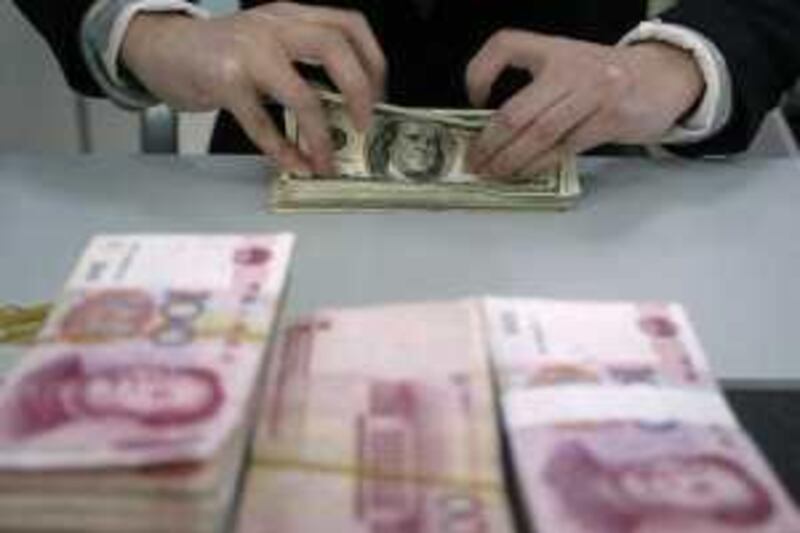With the global economy continuing to shrink and the outlook for a US recovery still gloomy, world attention has turned to China. Its projected 6.5 per cent growth and US$2 trillion (Dh7.34tn) foreign reserves gives it the appearance of the saviour of the global economy. But the Chinese government is preoccupied with a different agenda: how to protect its hard-earned savings from depreciation. While much of the world often thinks of China's currency reserves as a magic wand that can provide a huge stimulus to the global economy, Beijing sees it more like the Sword of Damocles hanging over its head.
For most of the past 30 years, Beijing has set a fixed exchange rate by pegging the renminbi to the US dollar, periodically intervening to keep its currency's exchange rate low. As long as the economy continued to grow by almost double-digit percentage terms every year and exports expanded, both the central and local authorities could claim success in job creation. China's trade and capital "twin surpluses" led to the accumulation of its enormous foreign reserves. Seeking safe investment returns, Beijing began to purchase more and more US treasury bills, financing the persistent US trade and budget "twin deficits", and in the process, becoming America's largest creditor.
But the US economic crisis and its government's large spending approach in battling it have created a nightmare as far as China is concerned. The huge US foreign debt, budget deficit and the large infusion of printed dollars, the Chinese are convinced, will lead to inflation and the eventual depreciation of the US dollar. And the process will drag down Chinese holdings in US treasury bills and other assets, which are worth well over $1tn now.
Today, the People's Republic of China has become the T-bill Republic and, as the economist Paul Krugman put it, China has now fallen into a "US dollar trap" and cannot get out of it, nor will anyone come to its rescue. So the Chinese are trying to help themselves by experimenting with two major measures. The first is to take steps to change the rules of the game altogether. Only days before the London summit of the Group of 20 (G20) leading and emerging economies early last month, Zhou Xiaochuan, the governor of China's central bank, penned an article blaming the US dollar's position as a structural cause of the financial crisis and calling for the use of IMF Special Drawing Rights (SDRs) as a global super currency to replace the US greenback.
It stirred up some support as well as controversy, with even some Chinese acknowledging that it was a long-shot proposal. But Beijing has not been all talk and no action. Its first step in realising such a fundamental change in the global financial order is to strengthen the renminbi's position. At the G20 summit, China indicated it would inject $40 billion into the IMF, possibly in the form of purchasing SDR bonds, thus pushing for IMF changes on its voting share.
And since the second half of last year, China has arranged and carried out currency swaps with many countries. These arrangements are worth more than $120bn, and there is more to come. The upshot is that many of China's trading activities with countries such as South Korea, Japan, Argentina, Indonesia, Malaysia and Belarus will be using renminbi as a settlement currency instead of the dollar. China is also moving to build closer financial ties with its Asian neighbours.
None of these are epoch-making developments but the renminbi strategy means the US dollar's domination of two thirds of the world's official currency reserves will begin to change. Another effort by China to pull itself out of the dollar trap is to diversify its global investment from low-return T-bills and volatile securities to energy and resource assets around the world. Leading the way are large Chinese mining companies, and the targets are primarily within the Australian mining sector. In three separate deals since February, the Chinese have acquired Australian mining assets totalling more than $20bn.
In the energy sector, China has entered a new wave of large deal-making with major global players. It just signed a $25bn agreement with Russia for 15 million tonnes of crude annually for 20 years, starting in 2011, while providing loans to Russian oil and pipeline companies. Beijing also has just concluded a $10bn oil-for-loan deal with Kazakhstan. Another $10bn agreement, with Brazil's Petrobras, is under way. Similar deals have been signed with Venezuela's oil companies, ExxonMobil and other western oil majors.
Viewed comprehensively, Beijing is apparently more determined than ever to avoid being snared in the traps of a "T-bill republic". It is instead trying to become a "hard-asset republic". Its challenge is to take just enough steps to walk away from the dollar, but not too fast or in too dramatic a fashion that it might hurt its US dollar holdings. China may not be the saviour of the world financial system as many thought and hoped, but its gradual move away from the dollar may eventually serve a long-term utility in the reorganisation of the global economic order.
Wenran Jiang is the Mactaggart Research Chair of the China Institute at the University of Alberta and a senior fellow at the Asia Pacific Foundation of Canada





